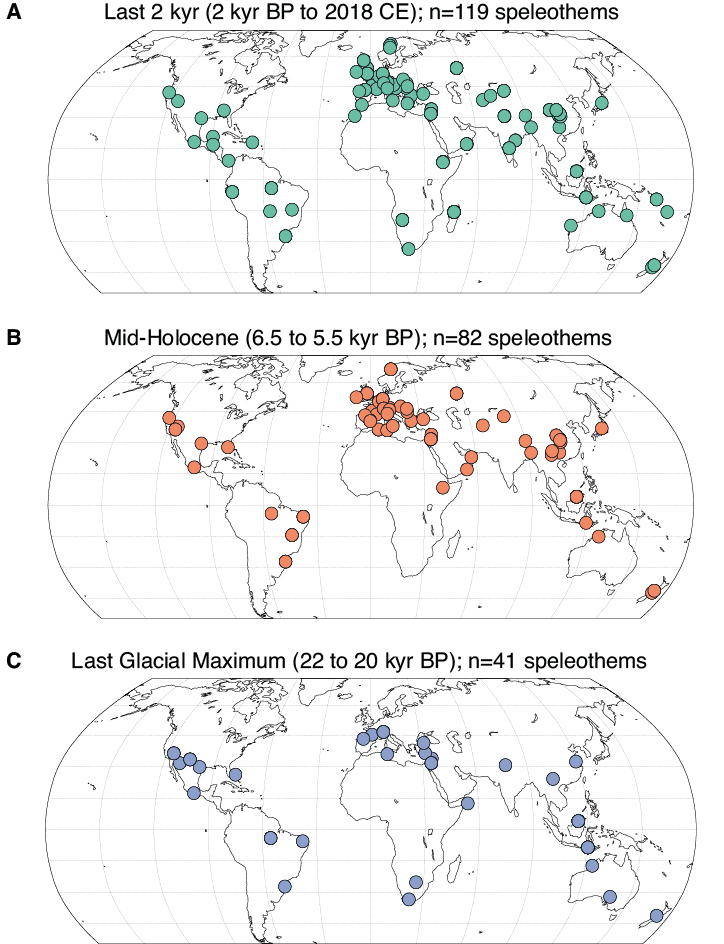- Home
- Publications
- PAGES Magazine
- Analyses of The SISAL Database: Regional Patterns In Isotope Signatures
Analyses of the SISAL database: Regional patterns in isotope signatures
Ait Brahim Y, Kaushal N & Comas-Bru L
Past Global Changes Magazine
27(1)
40
2019
Yassine Ait Brahim1, N. Kaushal2 and L. Comas-Bru3
3rd SISAL workshop, Agadir, Morocco, 8-12 October 2018
PAGES’ SISAL (Speleothem Isotope Synthesis and Analysis) working group was set up to create a database of speleothem δ18O and δ13C records and to synthesize these records for targeting climate questions such as investigating long-term drivers of the global monsoon and for data-model comparisons (Comas-Bru et al. 2017). The first version of the database (SISAL_v1; Atsawawaranunt et al. 2018a; Fig. 1), with 371 speleothem records and 10 composites from 174 cave systems, has been made available online with an accompanying paper describing its structure (Atsawawaranunt et al. 2018b).
Building on this foundation, the 3rd SISAL workshop was held from 8-12 October 2018 at Ibn Zohr University in Agadir, Morocco. Twenty-four participants, including 12 early-career researchers, came to Agadir from 14 countries. The SISAL members gave presentations about their SISAL-related activities on the first day. The discussions involved: (i) the current status of the database; (ii) an update by the age modeling group, which aims to provide a common denominator for age-uncertainty envelopes through the construction of a set of new age-depth models termed “SISAL chronologies” employing a range of commonly used techniques – a critical addition to the next version of the database (SISAL_v2); (iii) progress and feedback on the regional review papers that are part of a special issue in the journal Quaternary (mdpi.com/journal/quaternary/special_issues/speleothem_records_climate); and (iv) preliminary work on the first scientific SISAL paper and three additional papers using the SISAL database.
On the following three days, the analyses and discussions were centered around the first scientific SISAL paper (“Evaluating model outputs using integrated global speleothem records of climate change since the last glacial”) and the three additional papers currently in progress: “Hydrological records of the evolution of regional monsoons during the Holocene and the Last Interglacial”, “The Holocene from the speleothems’ view: Global trends and teleconnections”, and “The MCA/LIA as reflected by speleothems”. Participants separated into small groups to work on these analyses with daily feedback from the larger group. By the end of the workshop there were paper outlines with clearly defined timelines, preliminary analyses, and further steps to be taken. Data gaps of key climate events from different regions necessary to make these papers robust were identified and have been prioritized. In accordance with the co-authorship agreement created to encourage inclusivity, all researchers are welcome to contribute intellectually to these papers.
Two talks were given by participants at the workshop. On Day 1, Mike Rogerson presented an idea of drip water synthesis. On Day 3, Colin Prentice gave an invited talk titled “Stable carbon isotope ratios in plants and the atmosphere, from inter-annual variability to glacial-interglacial cycles”, reflecting on the idea of interpreting global patterns in speleothem δ13C records from the SISAL database.
During the workshop, it was decided that SISAL_v2, which will incorporate records identified as missing during the workshop and the SISAL chronologies, will be released in late 2019. In the closing session, participants discussed locations for the next workshop to be held in October 2019, a SISAL session and poster presentations at EGU 2019, potential collaborations with other PAGES working groups, funding sources, and the perspectives of SISAL’s future (e.g. the extension of the SISAL database with the addition of more records and/or, for example, trace element and drip water measurements). Finally, informal SISAL meetings at the INQUA 2019 and EGU 2019 conferences were scheduled.
The last day of the workshop was spent exploring the Wintimdouine cave (30.68°N, -9.34°W, 1400 m.a.s.l) and its associated geology. Located 70 km northeast of Agadir city, the Wintimdouine cave (i.e. "the spring of lakes” in the Moroccan Berber language) is developed within the karst system of Tasroukht in the Western High Atlas Mountains. It includes the longest known underground river in Africa with 19 km explored so far. Participants had the chance to enter the cave and examined various beautiful forms of speleothems.
Those researchers with data to add to the database are encouraged to contact the regional coordinator for the geographic area of their stalagmite record. The deadline for submission for the second version of the database is 30 June 2019. For more information about SISAL and how to get involved, go to pastglobalchanges.org/sisal
acknowledgements
We thank PAGES, Ibn Zohr University, University of Reading, and the Institute of Research for Development for their financial support. We also thank the Scientific Association of Speleology of Agadir for their assistance during the field trip.
affiliationS
1Institute of Global Environmental Change, Xi’an Jiaotong University, China
2Asian School of the Environment, Nanyang Technological University, Singapore
3School of Archaeology, Geography & Environmental Sciences, University of Reading, UK
contact
Yassin Ait Brahim: aitbrahim xjtu.edu.cn
xjtu.edu.cn
references
Atsawawaranunt K et al. (2018a) SISAL database Version 1.0. University of Reading. Dataset
Atsawawaranunt K et al. (2018b) Earth Syst Sci Data 10: 1687-1713

